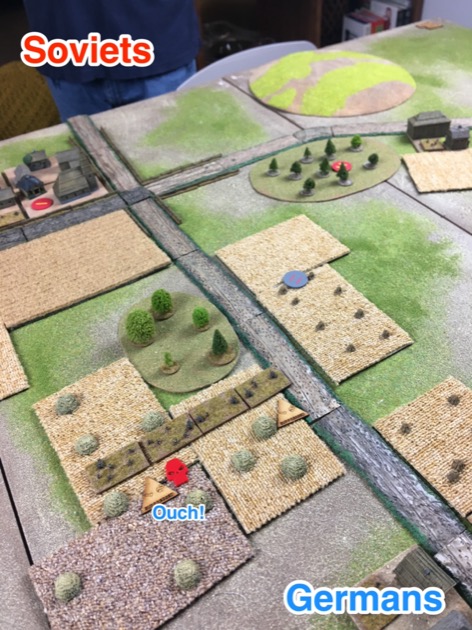I wanted some 15mm haystacks to enhance my carpet fields. So I purchased and painted some. I’m not Monet, but they’ll do for a game of Crossfire.

Adam’s Haystacks
I like the terrain Adam provided for the ‘O’ Group games we played recently. He has a very similar terrain style to me, in fact he borrowed some kit. But there is something Adam had and I didn’t: haystacks.
Assault on Kristov 2

Where to get 15mm haystacks
I got my haystacks from Battlescale: 15mm Scenics, specifically:
- Haystacks (A) (pack of 4)
- Haystacks (B) (pack of 4)
- Large Haystacks (C) (pack of 4)
I mainly purchased from them because I wanted their 12 piece Vine Section Set.

I would normally buy things like this from Timecast: Scenics. This is where Adam got his haystacks, although he collects in 6mm. In 15mm they offer:
- 37/003 – Traditional style European Hay Stacks (4 per pack). 4cm diameter, 2.5cm high.
- 37/014 – “Traditional” corn stooks (10 pieces per pack)
And Hovels: Accessories offer:
- 6a5 Haystacks traditional circular style (2 per pack)
Flames of War also have a pre-painted Battlefield in a Box: BB245 Haystacks (15mm).
How to paint haystacks
Surprisingly Google wasn’t very helpful in how to paint haystacks for wargaming. Monet, oil, yes. Vallejo acrylics, no. And, as I said, I don’t aspire to Monet.
I used four Vallejo paints and lots of dry brushing.

Steps:
- Undercoat in black. I undercoat everything in black
- Dry brush Vallejo (121) 70.913 Yellow Ochre
- Dry brush Vallejo (120) 70.976 Buff
- Dry brush Vallejo (016) 70.948 Golden Yellow
- Dry brush Vallejo (007) 70.837 Pale Sand
- Spray with matt vanish
I found after painting on the 70.976 Buff the haystacks were too white-ish and not yellow-ish enough, hence putting in a layer of 70.948 Golden Yellow. The result, after spraying with varnish is:

The result
Once put on the fields, as opposed to the black background of my spray painting board, the colour of the haystacks bleached out a bit. They probably need to be brightened up. I’d start with the base coat and in hindsight I should have gone heavier on the initial layer of 70.913 Yellow Ochre. And more 70.948 Golden Yellow.





Questions for you
Anybody know of other companies that provide 15mm haystacks?
These could be improved. I’m open to suggestions. So how could I improve my haystacks?


Have you considered a base coat of Ochre and then dry brush with your other colours. The black undercoat will alway darken them as the models look to be heavily textured.
I went through a phase of trying different undercoats but always found them unsatisfactory. So I just undercoat everything in black to make my brain stop hurting.
But as you say, black darkens everything. Which means more layers, or thicker layers, are necessary on top.
Sometimes I use the phrase “heavy dry brush” which means, leave more paint on the brush and go crazy. There isn’t much difference between this and painting a solid base coat, but there is some difference. It leaves flecks of darker shades in the creases.
I this case my first coat over black was Vallejo (121) 70.913 Yellow Ochre. I didn’t think about painting it on as a solid coat. But, as is typical with me, went for heavy dry brush instead. Next time I might go heavier.
I sympathise with your approach to undercoating. I am currently split with undercoating mid-brown for ancients and mid to dark grey for all other periods. The choice of colours is to minimise my painting mistakes showing.
Start with a heavy dry brush of white, then the other colors heavy enough to cover all the white.
Foxholeterrain.com has some. I think Peterpig sold some. 6 Squared Studios used to do some nice ones but they are not listed on the website any more. Also check out Etsy.